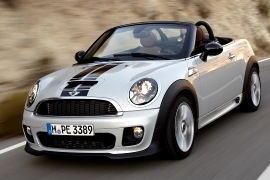MINI Roadster Models/Series Timeline, Specifications & Photos
First production year: 2011
Engines: Gasoline, Diesel
Body style: Convertible (spider/spyder, cabrio/cabriolet, drop/open/soft top)
British roadsters always had a specific flair, and in 2011, MINI came on the market with a two-seat cabriolet vehicle designed and built to thrill its customers.
MINI specialized in creating niche-market vehicles, and the Roadster was just a perfect example of that. In 2011, the British automaker launched this open-top model fit for two adults with a few significant advantages over the regular convertible version, such as a ten percent increase in the vehicle’s stiffness and a larger trunk. On the other hand, it came with a single downside, and that’s because it couldn’t carry as many people as the regular open-top version of the MINI hatchback could.
The 2011 MINI Roadster came with chromed surroundings for headlights, but unlike its cousin, its headlamps were tilted rearwards, like on the MINI Coupe. Between them, the automaker placed the trapezoidal grille with rounded corners and different mesh, depending on the engine version. Lower, on the apron, the automaker installed a second air intake flanked by the fog lamps’ scoops. On the hood, the S, the SD, and the Cooper Works version featured a scoop, while the base version didn’t.
From its profile, the Roadster boasted flared wheel arches with black plastic trims around the wheel arches. In addition, the side sills featured an air intake in front of the rear wheels. The raked windshield was supported by thick A-pillars, which also protected the occupants in case of a rollover crash. In addition, MINI installed a second set of roll bars behind the seats, which also served as protection against the draft. Unusual for this vehicle segment, the car sported an active spoiler on the trunk, which automatically deployed at speeds above 50 mph (80 kph) and returned to its position below 37 mph (60 kph). The driver could manually raise that aerodynamic element via a switch on the center stack. Finally, at the back, the automaker installed a wrap-around body-colored bumper with a center-mounted twin exhaust for the S, the SD, and the Cooper Works versions, while the naturally-aspirated model had a side-mounted pipe.
The cabin looked very similar to the rest of the MINI range, featuring high-bolstered seats for both occupants. Since it was a two-seat vehicle, the automaker could extend the seats’ travel from front to back. Another advantage of having the rear seats deleted was that the trunk was larger than in the regular convertible. In addition, a load-through hatch opened on the cockpit’s rear panel. In front of the driver, MINI placed the tachometer, while the center stack housed a large speedometer. The driver could cover or uncover the car while driving at speeds up to 20 mph (32 kph). While the canvas roof was power-operated, the latching and unlatching were manual.
Under the hood, MINI installed a choice of four engines ranging between 122 PS (120 hp) and 184 PS (182 hp), either gasoline or turbodiesel. Power went to the front wheels via a standard six-speed manual or a six-speed automatic, depending on the options.
